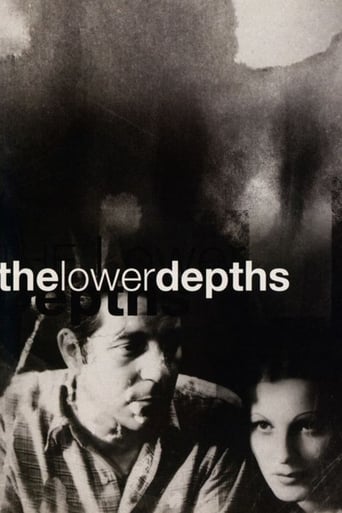

Wow! Such a good movie.
... View MoreTerrible acting, screenplay and direction.
... View MoreAm I Missing Something?
... View MoreI cannot think of one single thing that I would change about this film. The acting is incomparable, the directing deft, and the writing poignantly brilliant.
... View MoreStrictly speaking there are two alternate ways of making an adaption. One is to adapt the original text to the screen as it was written, the other is to modernize the text completely, thus giving it a new interpretation. These extremes locate to the opposite ends of the axle loyal-disloyal. Jean Renoir's "The Lower Depths" (1936) is far from the former, though it isn't particularly radical nor a modernization. One who is interested in the loyal fashion might wish to take a look at Kurosawa's 1957 version of the same material. The original material in question is Maxim Gorky's famous play of the same name which premiered in the early 1900's. Gorky's play is often regarded as a hallmark of socialist realism, but it lacks the unambiguous moral message which we usually associate with the style. It's a play without a formal plot, paying more attention to characters and their relationships. Renoir has changed a lot and added new milieus, scenes, and minor characters. For example, Renoir gives more space for the friendship between the bankrupt baron and the thief, probably in order to highlight his view of humanity above social borders. Overall, Renoir has taken the most interesting characters of Gorky's play and chosen to focus on their drama rather than creating a film about a cave-like milieu and its relation to its various inhabitants. It is the spectator's choice whether this is for the better or worse, but Renoir's motives seem clear: he most likely wanted to give coherence to the story and thus enhance its ethical nature. Due to these choices Renoir's "The Lower Depths" grows into a story about a thief (Jean Gabin) who falls in love with a girl. They live in the same slum -- a typical courtyard-ish milieu for Renoir's 30's films -- with the girl's sister, the thief's former partner, who is married to the owner of the slum apartments but wants to escape her marriage. Meanwhile the thief befriends a baron who has lost his social status and is now creating a new life in the lower depths.Gorky's story is really ideal to the French Poetic Realism, but the film has replaced Gorky's pessimism with warm romance and an optimistic spirit. To me, whether this makes "The Lower Depths" better or worse is not an interesting question. What is interesting, on the other hand, is that it makes it different. Renoir once again manages to approach themes of friendship and solidarity with an authentic yet non-sentimental perspective. The final shot, which has righteously been compared to the famous finale of Chaplin's "Modern Times" (1936), expresses faith and hope, but not in excess, precisely because Renoir's image is indeterminate enough. Or, as Luka puts it, "If you believe in it, it is real."
... View MoreThis was the first of three collaborations between Jean Gabin and Jean Renoir in the mid-late thirties and there is a distinct link between this and Le Grande Illusion in the friendship across the classes as epitomised in both films by Gabin's prole and respectively Louis Jouvet's and Pierre Fresnay's aristocrat. Gabin was a star in all but name by 1936 when this was shot and it came more or less in the centre of his great fertile first period surrounded by La Bandera, La Belle Equipe, Pepe Le Moko, Quai des Brumes, Le Bete Humaine etc. Louis Jouvet was first and foremost a man of the theatre but he made several successful forays into film and also had a masterpiece (Feyder's La Kermesse heroique) behind him when he made this. Not unnaturally he and Gabin walk away with the piece despite a 'flashy' turn by Robert Le Vigan and solid support by Suzy Prim. Despite Russian names none of the principals is convincing as a Russian - and to be fair they don't try all that hard - but they do, nevertheless, weigh in with some top of the line acting and though the 'happy' ending clashes with Gorky's original it remains a fine movie.
... View MoreThe Criterion Collection offers two different film versions of "The Lower Depths": one made in 1936 by Jean Renoir and another one made in 1957 by Kurosawa. The two directors never worked together on either film. In fact, they only met once in their lives, many years later. Both films are based on Russian writer Maxim Gorky's 1902 play, which describes life in a miserable slum where most characters have lost all sense of hope. Renoir deals with this serious subject matter in a much more humorous and amusing way than Kurosawa, whose film is slower, decidedly somber and a lot more difficult to digest. While Renoir's work takes the viewer in an out of the slums, Kurosawa doesn't allow one to see beyond the wretchedness of the underworld. Both films are great, but it was probably Kurosawa's which left a more durable and deeper impression on me.
... View MoreNow that Criterion has released not one but two 'Lower Depth' features, one by Renoir, the other by Kurosawa, you have a double bill of masterpieces to look forward to. Renoir's contribution to this menage is a surprisingly buoyant one. Gabin and Jouvet dominate the film with their mano-a-mano discussions on life and freedom. Suzy Prim is properly bitchy as the woman scorned, although Junie Astor as her oppressed sister doesn't have it in her to elevate the scenes that she's in. The plot is almost completely different from Gorky's, yet the playwright read and publicly approved of the project. In Renoir's world there is always a way out for those who are kind and strive. There are doomed souls too, but their fates are laid out in a gentle, loving manner. This isn't the best Renoir film, but it reflects his lifelong humanism and warmth (and many depth-of-field shots for those mise-en-scene fanatics). Needless to day, I enjoyed it thoroughly.
... View More